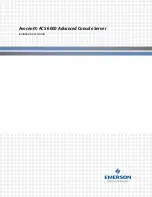
xii
This manual describes how to use and configure an HP Traffic Server™ system.
For information about installing Traffic Server and unsupported features and last minute information not
available in this manual, refer to the HP Web Cache Server Appliance (sa2100 or sa2200) Getting Started
Guide.
The manual discusses the following topics:
•
Chapter 1
provides an overview of the Traffic Server features and components
•
Chapter 2
through
Chapter 12
provide procedural information about starting, monitoring, configuring,
and maintaining the Traffic Server
•
Appendix A
through
Appendix F
provide Traffic Server reference information
Who should read this manual
This manual is intended for Traffic Server system administrators who configure, run, and administer Traffic
Server systems.
The manual assumes that you have experience in UNIX or Windows and Web server administration, and that
you are comfortable performing complex system configuration tasks, such as partitioning and formatting
disks, setting up TCP/IP ports, and establishing DNS round robin services.
Conventions used in this manual
This manual uses the following typographic conventions.
Preface
Convention
Purpose
italics
Represent emphasis and introduce terms; for example, “the reverse proxy
option.”
bold
Represents graphical user interface options and menu names; for example,
click the Protocols button.
monospaced face
Represents commands, file names, file content, and computer input and
output; for example, “use the
reconfigure
command.”
monospaced italic
Represents variables for which you should substitute a value; for example,
“enter
filename
.”
brackets [ ]
Enclose optional command arguments in command syntax; for example,
add
pathname [size]
.
vertical bar |
Separates value options in command syntax; for example,
open tcp|udp ports o_ports
.













































